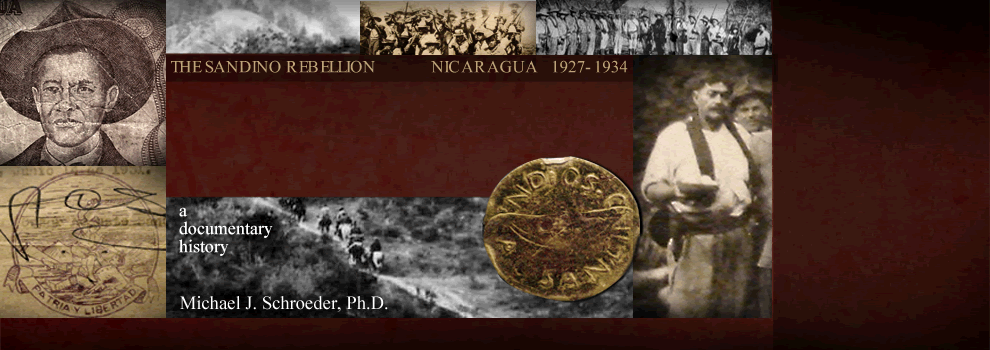Cuartel General, 1er Batallón, 11o Regimiento,
Cuerpo Marino de los EE.UU.
León, Nicaragua 22 de junio 1927.
De:
Primer Teniente Merton A. Richal, Cuerpo
Marino de los EE.UU.
A: El
Oficial al mando.
Asunto: Informe de patrulla al Valle de
los Zapatas.
1. En cumplimiento de las órdenes de
fecha 19 de junio 1927, el abajo
firmante realizó una patrulla de siete
hombres hasta el pueblo de Valle de los
Zapatas para investigar depredaciones e
incendios en ese lugar y se presenta el
siguiente informe:
ITINERARIO
Salió León a las 05:00h el 20 de junio;
llegó San Jacinto a las 10:45h; salió
San Jacinto a las 13:00h; llegó Apanti a
las 14:20h; salió Apanti a las 14:30h;
llegó Valle de los Zapatas a las 16:45h
el 20 de junio.
Salió Valle de los Zapatas 07:15h, el 21
de junio, llegó Rota 10:15h; salió rota
a las 10:30h; llegó Laceibita a las
12:30h; salió Laceibita a las 14:30h;
llegó León a las 17:15h.
ESTADO DEL PAIS Y LAS
CARRETERAS
Todos los campos aparecían estar bajo de
cultivo, la cosecha más común era el
maíz, y muchos nativos estaban
trabajando en los campos.
Numerosos rebaños de ganado y muchos
caballos y mulas estaban pastoreando en
pastizales. Los campos durante unos doce
kilómetros desde León están cultivados
extensamente. De allí hasta Apanti el
país está muy arbolado y silvestre. Hay
un área cultivado de los alrededores de
Apanti de un radio de una milla
aproximadamente y después hay desierto
hasta que se alcanza las proximidades
del Valle de los Zapatas, donde hay más
campos cultivados y pastizales.
La carretera de León a San Jacinto es
transitable para carretas tirada por
bueyes, y no existen ningunas pendientes
pronunciadas. Los principales obstáculos
encontrados fueron agujeros de barro. De
San Jacinto a Apanti la ruta recorrida
era sólo un camino muy empinado y rocoso
y absolutamente intransitable para
carretas. La guía decía que había una
carretera para carretas entre los dos
lugares, pero que era peor para los
caballos que el que utilizamos. De
Apanti hasta el Valle de los Zapatas el
camino era bastante llano y pasable para
carretas pero habían muchos agujeros de
barro y era muy resbaladizo debido a la
naturaleza del suelo arcilloso. La ruta
del viaje de regreso a León fue a través
de una carretera transitable para
carretas. Habían unos cuantos pendientes
pronunciadas y muchos agujeros de barro
pero fue la ruta principal al norte de
León.
PUEBLOS EN RUTA
Apanti, a unos veinte kilómetros de
León, es una colección de unos seis o
siete casas y sin tiendas. El ciudadano
principal o Comandante es Timoteo Flori.
[Pág. 2]
Valle de los Zapatas es una aldea de
sola una calle, de unas veinte casas,
150 habitantes, una iglesia y una tienda
abandonada. El ciudadano principal o
Alcalde es Prudensio Silbar.
INFORMES DE depredaciones y bandidos.
No habían signos o informes de bandidos
a lo largo de la ruta al Valle de los
Zapatas pero en aquel lugar seis casas
habían sido quemadas, la tienda
aparentemente saqueado y el propietario
fue echado fuera, o se había ido de su
propia voluntad. Nadie en la ciudad
había sido asesinado por bandidos.
Los nombres de los propietarios de las
casas quemadas son Rebeca Novoa
(conservador), Matias Silba
(conservador), Francisco González
(conservador), Estebana Pichardo
(liberal), Domingo Norvais
(conservador).
Francisco González fue entrevistado y
declaró que no habían bandidos en el
pueblo en la actualidad pero que algunos
habían llegado ayer, y el día anterior
(18 y 19 de junio). Él no sabía cuantos
habían ya que vinieron de noche y no se
acercaron a su casa. No los vio, y no
sabia de dónde vinieron ni por donde se
dirigieron.
Jesús Hando fue entrevistado y dijo que
los bandidos habían llegado al pueblo
hace unas dos semanas y quemaron las
seis casas. Fueron también a varias
otras casas y preguntaron por un hombre
que no se conocía. También dijo que tres
bandidos habían llegado ayer al pueblo
(19 de junio). Él no vio a ningunos de
los bandidos, y no sabía de dónde
vinieron ni por donde se dirigieron. Él
dijo que nadie del pueblo sabía quiénes
eran los bandidos. (Se cree que los
bandidos que se informaron de haber
entrado el pueblo el 19 de junio eran
policía nativos en camino de El Sauce.)
María Luisa González fue entrevistado y
dijo que hacia las 23:00h, el 17 de
junio, cuatro bandidos armados con dos
pistolas y un rifle llegaron a su casa,
la amenazaron y la obligaron a darles
comida. Ella dijo que reconoció a uno de
los bandidos como Ventura Caballero,
viviendo en Posoltega.
No se podía obtener más información
sobre los bandidos. Los habitantes del
Valle de los Zapatas parecían un poco
cauteloso a la hora de dar información,
pero eran muy agradable y no hosco en
absoluto. Dijeron que querían protección
de los marinos y que ellos anticipaban a
los bandidos de venir de vuelta
cualquier día después de que saliera la
patrulla marina.
- - - - - M. A. Richal - - - 23 de junio
1927 - - - - -
Gracias a Linda Pudder por su traducción de este
informe.
RG127/209/1.

